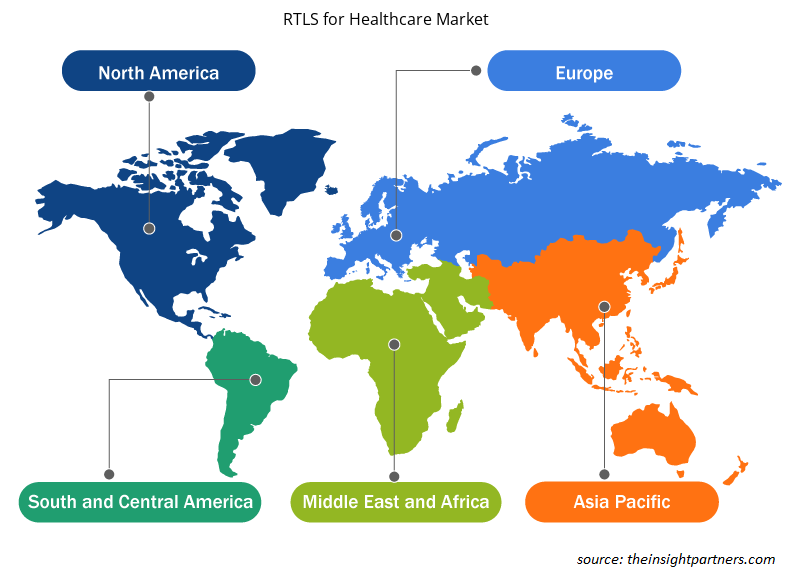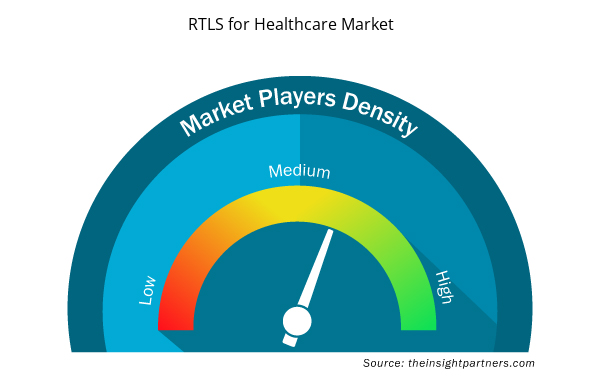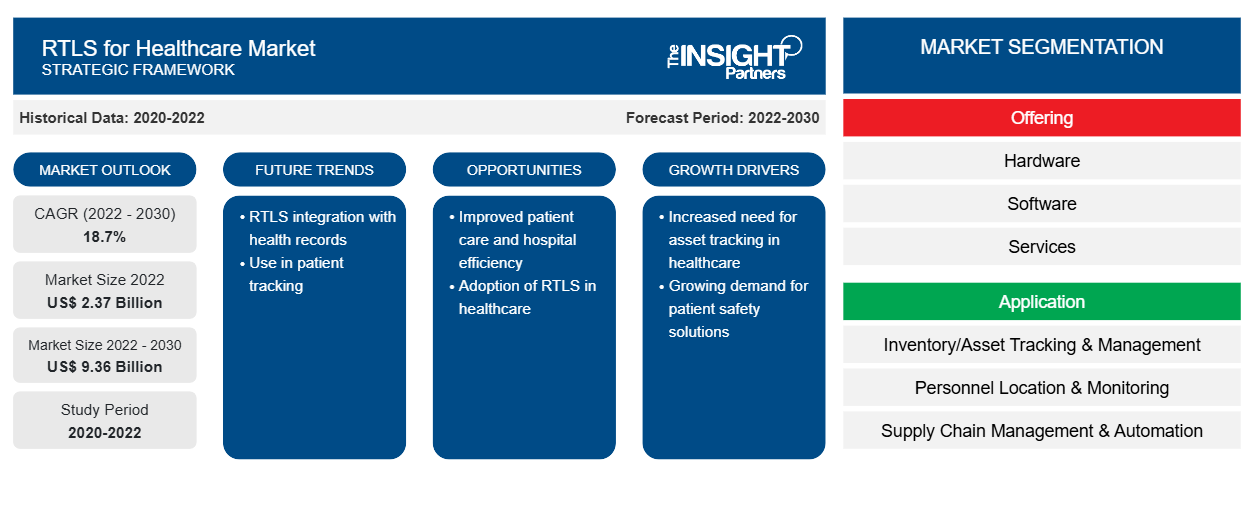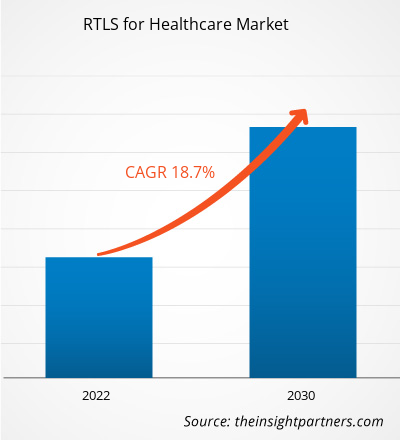[Informe de investigación] El mercado de RTLS para el cuidado de la salud se valoró en 2.370 millones de dólares estadounidenses en 2022 y se proyecta que alcance los 9.360 millones de dólares estadounidenses en 2030. Se espera que registre una CAGR del 18,7 % en 2022-2030.
Perspectivas del mercado y opinión de analistas:
Los servicios de localización en tiempo real (RTLS) en el ámbito sanitario se utilizan para proporcionar un seguimiento en tiempo real, así como la gestión del personal, el equipo médico y los pacientes en todo tipo de centros sanitarios. Los centros sanitarios, como hospitales, residencias para personas mayores, centros ambulatorios y laboratorios de diagnóstico, utilizan RTLS para realizar un seguimiento de los equipos médicos, los pacientes, los profesionales sanitarios y los informes. Por ejemplo, las residencias para personas mayores utilizan etiquetas e insignias conectadas a través de RTLS para realizar un seguimiento de la población geriátrica que padece principalmente la enfermedad de Alzheimer o que sufre pérdida de memoria. La creciente conciencia sobre las ventajas de RTLS para la gestión del personal y el alto retorno de la inversión con un gasto de capital reducido impulsan el tamaño del mercado de RTLS para la atención sanitaria .
Factores impulsores del crecimiento y desafíos:
La escasez de profesionales sanitarios y el aumento del uso de RTLS se encuentran entre los factores que impulsan el crecimiento del mercado de RTLS para la atención sanitaria. Ha habido una escasez considerable en el número de profesionales sanitarios en todo el mundo. En 2020, el primer informe del Estado de la enfermería en el mundo (SOWN), publicado por la Organización Mundial de la Salud (OMS), afirmó que la fuerza laboral de enfermería era de 27,9 millones a nivel mundial y proyectó un déficit de 5,9 millones de enfermeras para 2030 a nivel mundial. Según los datos de la Asociación de Facultades Médicas de Estados Unidos (AAMC), se espera que EE. UU. se enfrente a una escasez de unos 120.000 médicos para 2030, lo que afectará a la atención general al paciente en todo el país. En un artículo publicado por Siemens, las enfermeras pasan unos 72 minutos por turno buscando equipos, y la tasa media de utilización de los equipos es inferior al 40%, mientras que la proporción de activos perdidos o robados se estima en alrededor del 10% en instalaciones sin servicios de localización en tiempo real (RTLS). Con la escasez de personal, la búsqueda de equipos se convierte en una tarea innecesaria para las enfermeras. Por lo tanto, para administrar el tiempo del personal disponible, los centros de salud se están enfocando en instalar sistemas RTLS a través de los cuales pueden localizar fácilmente el equipo o el personal requerido. Por lo tanto, debido a la escasez de profesionales de la salud, los centros de salud han comenzado a utilizar la tecnología RTLS para administrar el flujo de trabajo en sus instalaciones.
Se espera que el uso de la tecnología RTLS para una conectividad adecuada durante la atención médica domiciliaria traiga nuevas tendencias del mercado RTLS para la atención médica en los próximos años.
Personalice este informe según sus necesidades
Obtendrá personalización en cualquier informe, sin cargo, incluidas partes de este informe o análisis a nivel de país, paquete de datos de Excel, así como también grandes ofertas y descuentos para empresas emergentes y universidades.
- Obtenga las principales tendencias clave del mercado de este informe.Esta muestra GRATUITA incluirá análisis de datos, desde tendencias del mercado hasta estimaciones y pronósticos.
Segmentación y alcance del informe:
El análisis del mercado de RTLS para el sector sanitario se ha llevado a cabo teniendo en cuenta los siguientes segmentos: oferta, tecnología, aplicación, tipo de instalación y geografía. Según la oferta, el mercado se segmenta en hardware, software y servicios. El segmento de hardware se segmenta a su vez en lectores/rastreadores/puntos de acceso, etiquetas/insignias y otro hardware. El segmento de servicios se divide a su vez en consultoría, implementación e integración, y soporte y mantenimiento. Según la aplicación, el mercado se divide en seguimiento y gestión de inventario/activos, localización y supervisión de personal, gestión y automatización de la cadena de suministro , entre otros.
En términos de tecnología, el mercado está segmentado en Wi-Fi, RFID y otros. Por tipo de instalación, el mercado está segmentado en hospitales y centros de salud, y residencias para personas mayores. Geográficamente, el mercado RTLS para atención médica se divide principalmente en América del Norte (EE. UU., Canadá y México), Europa (España, Reino Unido, Alemania, Francia, Italia y el resto de Europa), Asia Pacífico (Corea del Sur, China, India, Japón, Australia y el resto de Asia Pacífico), Medio Oriente y África (Sudáfrica, Arabia Saudita, Emiratos Árabes Unidos y el resto de Medio Oriente y África), y América del Sur y Central (Brasil, Argentina y el resto de América del Sur y Central).
Análisis segmental:
El mercado de RTLS para el cuidado de la salud, por oferta, se segmenta en hardware, y software y servicios. El hardware se segmenta a su vez en lectores/rastreadores/puntos de acceso, etiquetas/insignias y otro hardware. En 2022, el segmento de software y servicios tuvo la mayor participación del mercado y se espera que registre la CAGR más alta durante 2022-2030. El crecimiento del segmento de software y servicios está impulsado por los lanzamientos de productos de software por parte de las empresas para mejorar la eficiencia de los sistemas RTLS . Por ejemplo, en junio de 2021, Midmark RTLS lanzó una solución de seguimiento de activos basada en la nube, Bluetooth Low Energy (BLE), que moderniza las capacidades de seguimiento de activos.
Según la aplicación, el mercado se divide en seguimiento y gestión de inventarios y activos, localización y supervisión de personal, gestión y automatización de la cadena de suministro, entre otros. En 2022, el segmento de seguimiento y gestión de inventarios y activos tuvo la mayor participación en el mercado de RTLS para el sector sanitario. Se espera que el segmento de localización y supervisión de personal registre la CAGR más alta durante el período 2022-2030.
Según la tecnología, el mercado de RTLS para el cuidado de la salud se segmenta en Wi-Fi, identificación por radiofrecuencia (RFID) y otros. En 2022, el segmento RFID tuvo la mayor participación del mercado y se espera que registre la CAGR más alta durante 2022-2030.
El mercado, por tipo de establecimiento, está segmentado en hospitales y centros de atención médica, y residencias para personas mayores. En 2022, el segmento de hospitales y clínicas tuvo una mayor participación en el mercado de RTLS para la atención médica y se espera que registre una CAGR más alta durante 2022-2030.
Análisis regional:
El alcance del informe del mercado de RTLS para la atención médica se centra en América del Norte, Europa, Asia Pacífico, Oriente Medio y África, y América del Sur y Central. Se prevé que Asia Pacífico muestre la CAGR más alta del mercado durante 2022-2030. América del Norte tuvo la mayor participación del mercado global en 2022 debido al creciente número de hospitales tecnológicamente avanzados, el creciente uso de RTLS en residencias para personas mayores y atención domiciliaria, y la presencia de actores clave del mercado involucrados en desarrollos de productos nuevos y existentes. América del Norte es el mayor contribuyente al crecimiento del mercado de RTLS para la atención médica. En América del Norte, EE. UU. tuvo la mayor participación del mercado en 2022.
Desarrollos industriales y oportunidades futuras:
El pronóstico del mercado de RTLS para la atención médica se estima en función de diversos hallazgos de investigación primaria y secundaria, como publicaciones de empresas clave, datos de asociaciones y bases de datos. A continuación, se enumeran algunos planes de los actores clave que operan en el mercado de RTLS para la atención médica:
- En abril de 2022, Cognosos lanzó un nuevo paquete de software para equipos médicos denominado Proactive Periodic Automated Replenishment (ProPAR). ProPAR es una versión digital de los paneles y soluciones RTLS que respaldan a los equipos de suministro central e ingeniería biomédica al brindar visibilidad instantánea de los recuentos de activos y los umbrales de nivel de PAR en los centros de atención médica. ProPAR aprovecha la solución de motor de ubicación RTLS para interiores de Cognosos, LocationAI, que brinda visibilidad a nivel de habitación de la ubicación del equipo, lo que elimina la necesidad de buscar equipos para limpieza o recirculación, mantenimiento y ayuda a garantizar que los niveles de PAR se cumplan de manera constante.
- En julio de 2020, Advantech lanzó su paquete listo para la solución RTLS (SRP) diseñado para la localización y el monitoreo en tiempo real de equipos médicos, personal y pacientes. El SRP RTLS de Advantech es una solución de hardware y software que incluye sensores de ubicación, servidores de borde, etiquetas, tabletas de grado médico, paneles de control y software de gestión RTLS. La integración de la tecnología de fusión dinámica de detección multimodo (MSDF) de Advantech con el SRP RTLS reduce la interferencia de obstáculos y mejora el rendimiento de posicionamiento en entornos interiores complejos.
Perspectivas regionales del mercado de RTLS para la atención sanitaria
Los analistas de Insight Partners explicaron en detalle las tendencias y los factores regionales que influyen en el mercado de RTLS para atención médica durante el período de pronóstico. Esta sección también analiza los segmentos y la geografía del mercado de RTLS para atención médica en América del Norte, Europa, Asia Pacífico, Oriente Medio y África, y América del Sur y Central.

- Obtenga los datos regionales específicos para el mercado de RTLS para el cuidado de la salud
Alcance del informe de mercado de RTLS para atención médica
| Atributo del informe | Detalles |
|---|---|
| Tamaño del mercado en 2022 | US$ 2.37 mil millones |
| Tamaño del mercado en 2030 | US$ 9.36 mil millones |
| CAGR global (2022-2030) | 18,7% |
| Datos históricos | 2020-2022 |
| Período de pronóstico | 2022-2030 |
| Segmentos cubiertos | Al ofrecer
|
| Regiones y países cubiertos | América del norte
|
| Líderes del mercado y perfiles de empresas clave |
|
Densidad de actores del mercado: comprensión de su impacto en la dinámica empresarial
El mercado de RTLS para el sector sanitario está creciendo rápidamente, impulsado por la creciente demanda de los usuarios finales debido a factores como la evolución de las preferencias de los consumidores, los avances tecnológicos y una mayor conciencia de los beneficios del producto. A medida que aumenta la demanda, las empresas amplían sus ofertas, innovan para satisfacer las necesidades de los consumidores y aprovechan las tendencias emergentes, lo que impulsa aún más el crecimiento del mercado.
La densidad de actores del mercado se refiere a la distribución de las empresas o firmas que operan dentro de un mercado o industria en particular. Indica cuántos competidores (actores del mercado) están presentes en un espacio de mercado determinado en relación con su tamaño o valor total de mercado.
Las principales empresas que operan en el mercado RTLS para el cuidado de la salud son:
- CenTrak Inc
- Tecnología avanzada
- Securitas Healthcare LLC
- Tecnologías Zebra
- Redes de Aruba
Descargo de responsabilidad : Las empresas enumeradas anteriormente no están clasificadas en ningún orden particular.

- Obtenga una descripción general de los principales actores clave del mercado RTLS para atención médica
Panorama competitivo y empresas clave:
CenTrak Inc, Advantech, Securitas Healthcare LLC, Zebra Technologies, Aruba Networks, GE Healthcare, Ubisense, TeleTracking Technologies, Siemens Healthcare Pvt Ltd y HID Global Corporation se encuentran entre los actores destacados que aparecen en el informe del mercado de RTLS para el sector sanitario. Además, se han estudiado y analizado varios otros actores durante el estudio para obtener una visión holística del mercado y su ecosistema. Estas empresas se centran en las expansiones geográficas y los lanzamientos de nuevos productos para satisfacer la creciente demanda de los consumidores de todo el mundo y aumentar su gama de productos en carteras especializadas. Su presencia global les permite atender a una gran base de clientes, lo que facilita posteriormente la expansión del mercado.
- Análisis histórico (2 años), año base, pronóstico (7 años) con CAGR
- Análisis PEST y FODA
- Tamaño del mercado Valor/volumen: global, regional, nacional
- Industria y panorama competitivo
- Conjunto de datos de Excel



Report Coverage
Revenue forecast, Company Analysis, Industry landscape, Growth factors, and Trends

Segment Covered
This text is related
to segments covered.

Regional Scope
North America, Europe, Asia Pacific, Middle East & Africa, South & Central America

Country Scope
This text is related
to country scope.
Preguntas frecuentes
The RTLS for healthcare market, by offering, is segmented into hardware, and software & services. Hardware is further segmented into readers/trackers/access points, tags/badges, and other hardware. In 2022, the software & services segment held the largest share of the market and is expected to record the highest CAGR during 2022–2030. The software & services segment growth is driven by software product launches by companies to improve the efficiency of RTLS systems. For instance, in June 2021, Midmark RTLS launched a cloud-based, Bluetooth Low Energy (BLE) asset tracking solution, which modernizes asset tracking capabilities.
Based on application, the market is divided into inventory/asset tracking & management, personnel locating & monitoring, supply chain management & automation, and others. In 2022, the inventory/asset tracking & management segment held the largest RTLS for healthcare market share. The personnel locating & monitoring segment is expected to record the highest CAGR during 2022–2030.
Based on technology, the RTLS for healthcare market is segmented into Wi-Fi, Radio-Frequency Identification (RFID), and others. In 2022, the RFID segment held the largest share of the market and is expected to record the highest CAGR during 2022–2030.
The market, by facility type, is segmented into hospital and healthcare facilities, and senior living facilities. In 2022, the hospitals and clinics segment held a larger RTLS for healthcare market share and is expected to record a higher CAGR during 2022–2030.
Based on geography, the RTLS for healthcare market is segmented into North America (the US, Canada, and Mexico), Europe (the UK, Germany, France, Italy, Spain, and the Rest of Europe), Asia Pacific (China, Japan, India, South Korea, Australia, and the Rest of Asia Pacific), the Middle East & Africa (the UAE, Saudi Arabia, South Africa, and Rest of the Middle East & Africa), and South & Central America (Brazil, Argentina, and the Rest of South & Central America). North America is the largest contributor to the growth of the global RTLS for healthcare market. Asia Pacific is expected to register the highest CAGR in the RTLS for healthcare market during 2022–2030.
Real-time location services (RTLS) in healthcare are used to provide real-time tracking as well as management of staff, medical equipment, and patients in all types of healthcare facilities. Healthcare facilities such as hospitals, senior living facilities, ambulatory centers, and diagnostic laboratories are using RTLS to track medical equipment, patients, healthcare professionals, and reports. For instance, senior living facilities uses tags and badges connected through RTLS to track the geriatric population majorly suffering from Alzheimer’s disease or who suffer from memory loss. Increasing awareness about the advantages of RTLS for staff management and high return on investment with reduced capital expenditure propels the RTLS for healthcare market growth size.
Increasing awareness about the advantages of RTLS for staff management and high return on investment with reduced capital expenditure propel the RTLS for healthcare market growth. However, data security and privacy issues hinder the growth of the market.
The RTLS for healthcare market majorly consists of the players such CenTrak Inc, Advantech, Securitas Healthcare LLC, Zebra Technologies, Aruba Networks, GE Healthcare, Ubisense, TeleTracking Technologies, Siemens Healthcare Pvt Ltd, and HID Global Corporation.
Trends and growth analysis reports related to Technology, Media and Telecommunications : READ MORE..
The List of Companies - RTLS for Healthcare Market
- CenTrak Inc
- Advantech
- Securitas Healthcare LLC
- Zebra Technologies
- Aruba Networks
- GE Healthcare
- Ubisense
- TeleTracking Technologies
- Siemens Healthcare Pvt Ltd
- HID Global Corporation
The Insight Partners performs research in 4 major stages: Data Collection & Secondary Research, Primary Research, Data Analysis and Data Triangulation & Final Review.
- Data Collection and Secondary Research:
As a market research and consulting firm operating from a decade, we have published and advised several client across the globe. First step for any study will start with an assessment of currently available data and insights from existing reports. Further, historical and current market information is collected from Investor Presentations, Annual Reports, SEC Filings, etc., and other information related to company’s performance and market positioning are gathered from Paid Databases (Factiva, Hoovers, and Reuters) and various other publications available in public domain.
Several associations trade associates, technical forums, institutes, societies and organization are accessed to gain technical as well as market related insights through their publications such as research papers, blogs and press releases related to the studies are referred to get cues about the market. Further, white papers, journals, magazines, and other news articles published in last 3 years are scrutinized and analyzed to understand the current market trends.
- Primary Research:
The primarily interview analysis comprise of data obtained from industry participants interview and answers to survey questions gathered by in-house primary team.
For primary research, interviews are conducted with industry experts/CEOs/Marketing Managers/VPs/Subject Matter Experts from both demand and supply side to get a 360-degree view of the market. The primary team conducts several interviews based on the complexity of the markets to understand the various market trends and dynamics which makes research more credible and precise.
A typical research interview fulfils the following functions:
- Provides first-hand information on the market size, market trends, growth trends, competitive landscape, and outlook
- Validates and strengthens in-house secondary research findings
- Develops the analysis team’s expertise and market understanding
Primary research involves email interactions and telephone interviews for each market, category, segment, and sub-segment across geographies. The participants who typically take part in such a process include, but are not limited to:
- Industry participants: VPs, business development managers, market intelligence managers and national sales managers
- Outside experts: Valuation experts, research analysts and key opinion leaders specializing in the electronics and semiconductor industry.
Below is the breakup of our primary respondents by company, designation, and region:

Once we receive the confirmation from primary research sources or primary respondents, we finalize the base year market estimation and forecast the data as per the macroeconomic and microeconomic factors assessed during data collection.
- Data Analysis:
Once data is validated through both secondary as well as primary respondents, we finalize the market estimations by hypothesis formulation and factor analysis at regional and country level.
- Macro-Economic Factor Analysis:
We analyse macroeconomic indicators such the gross domestic product (GDP), increase in the demand for goods and services across industries, technological advancement, regional economic growth, governmental policies, the influence of COVID-19, PEST analysis, and other aspects. This analysis aids in setting benchmarks for various nations/regions and approximating market splits. Additionally, the general trend of the aforementioned components aid in determining the market's development possibilities.
- Country Level Data:
Various factors that are especially aligned to the country are taken into account to determine the market size for a certain area and country, including the presence of vendors, such as headquarters and offices, the country's GDP, demand patterns, and industry growth. To comprehend the market dynamics for the nation, a number of growth variables, inhibitors, application areas, and current market trends are researched. The aforementioned elements aid in determining the country's overall market's growth potential.
- Company Profile:
The “Table of Contents” is formulated by listing and analyzing more than 25 - 30 companies operating in the market ecosystem across geographies. However, we profile only 10 companies as a standard practice in our syndicate reports. These 10 companies comprise leading, emerging, and regional players. Nonetheless, our analysis is not restricted to the 10 listed companies, we also analyze other companies present in the market to develop a holistic view and understand the prevailing trends. The “Company Profiles” section in the report covers key facts, business description, products & services, financial information, SWOT analysis, and key developments. The financial information presented is extracted from the annual reports and official documents of the publicly listed companies. Upon collecting the information for the sections of respective companies, we verify them via various primary sources and then compile the data in respective company profiles. The company level information helps us in deriving the base number as well as in forecasting the market size.
- Developing Base Number:
Aggregation of sales statistics (2020-2022) and macro-economic factor, and other secondary and primary research insights are utilized to arrive at base number and related market shares for 2022. The data gaps are identified in this step and relevant market data is analyzed, collected from paid primary interviews or databases. On finalizing the base year market size, forecasts are developed on the basis of macro-economic, industry and market growth factors and company level analysis.
- Data Triangulation and Final Review:
The market findings and base year market size calculations are validated from supply as well as demand side. Demand side validations are based on macro-economic factor analysis and benchmarks for respective regions and countries. In case of supply side validations, revenues of major companies are estimated (in case not available) based on industry benchmark, approximate number of employees, product portfolio, and primary interviews revenues are gathered. Further revenue from target product/service segment is assessed to avoid overshooting of market statistics. In case of heavy deviations between supply and demand side values, all thes steps are repeated to achieve synchronization.
We follow an iterative model, wherein we share our research findings with Subject Matter Experts (SME’s) and Key Opinion Leaders (KOLs) until consensus view of the market is not formulated – this model negates any drastic deviation in the opinions of experts. Only validated and universally acceptable research findings are quoted in our reports.
We have important check points that we use to validate our research findings – which we call – data triangulation, where we validate the information, we generate from secondary sources with primary interviews and then we re-validate with our internal data bases and Subject matter experts. This comprehensive model enables us to deliver high quality, reliable data in shortest possible time.


 Obtenga una muestra gratuita de este informe
Obtenga una muestra gratuita de este informe